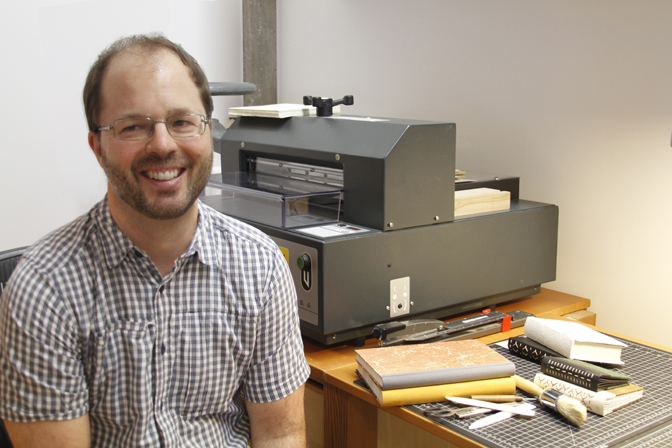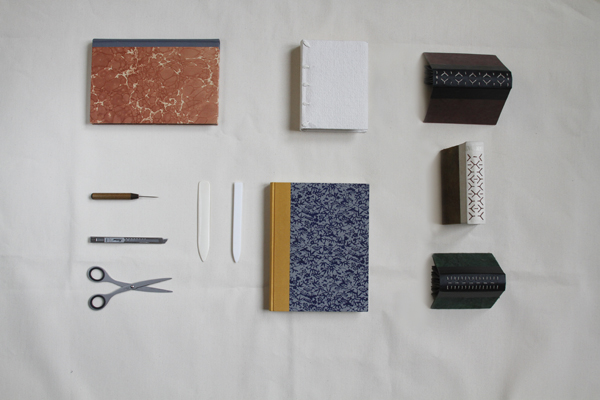What follows is an interview with Wade Berridge (a member of the Paperblanks production team!) and Nadine Werner, a professional book binder based in Beseland, Germany — two people we work with extensively. In order to shed some light on this rather arcane profession, both book binders took the time to talk about their passion for the art of bookmaking.

What drew you to book binding?
NADINE: I started bookbinding when I was 12 years old and as a teenager learned more about the profession by enrolling in an internship at a bookbindery in Hamburg. After high school I did another internship with a bookbinder in Philadelphia, but was not sure at that point if I should turn my hobby into a career. I decided to do a 3 year apprenticeship to find out and today am very happy that I chose this path. Every day of my life is devoted to my passion to work with paper.
WADE: I met a girl at the Alberta College of Art who showed me a beautiful Japanese style, side-stitched journal which she made out of hand-made paper. She had taken a weekend bookbinding course in Vancouver, BC. A light bulb went off and my concept of a book changed from a mysterious industrial product to an accessible piece of art.
How did you become a bookbinder?
NADINE: After I completed my bookbinding apprenticeship in Hamburg I spent two years studying design at the Academy for Design in Kassel, Germany. I also enrolled in courses at the Centro del bel libro in Ascona and then traveled for one year around New Zealand working with various bookbinders. Since 2005, I’ve been freelancing as a book and paper designer in the little village of Beseland, Germany.

WADE: Shortly after moving to Vancouver I found a great paper making studio called Kakali Handmade Papers. The studio offered weekend courses in bookbinding and I took every course they offered. One of the courses was by Keith Smith who has written about 8 books on bookbinding. I bought his books and continued my bookbinding education through his books.
Are there any particular styles of bookbinding that you prefer?
NADINE: I love adhesive-free bindings. I like when books open flat and you can see the binding structure.
WADE: This keeps changing. Initially, I was only interested in books that showed the stitching on the exposed spines of the book, such as sewing onto straps or Coptic stitching. I’ve since become more interested in the more formal art of fine bookbinding.
What book binders do you love?
NADINE: The Hedi Kyle course in Ascona was great and her works inspires me a lot. But I also like bindings from the Bauhaus era and the beautiful work of Japanese designs.

WADE: Keith Smith was probably the most accessible for me because he has written extensively and beautifully on the art of handmade books. In terms of Artist Books, his approach to binding is that it should be an integral part of the process of creating the whole book rather than an afterthought.
Do you have a favorite part of the process?
NADINE: It is great that there are so many different processes as a bookbinder, but I particularly like to combine techniques, patterns and materials from other crafts to create new techniques and binding designs.
WADE: If I’m working on an open-spine book, then it would be coming up with creative ways to sew the signatures together. When I took a course on traditional bookbinding, though, I really enjoyed the process of rounding the spine. This involves hammering the spine of the book block into a convex shape.
How can people enter the trade?
NADINE: In Germany you can do an apprenticeship or you can study book design or restoration. The centro del bel libro in Ascona/Switzerland has great courses and I know a lot of bookbinders from around the world who spend many month taking courses there.

I think the best way to learn about the profession is to ask for internships and talk to craft people, because you might find that there are avenues within the bookbinding field that you could pursue specifically, such as bookbinding, book restoration, book design. But there’s also paper engineering, supplying/creating book props for movies, book arts, artist books, pop-up books structures, package design…
WADE: Bookbinding as a trade seems to be more of a viable option in Europe than it is in North America. In Canada, there is the CBBAG located in Toronto. It is a great resource for traditional bookbinding and book arts in Canada. And they offer home study programs in Bookbinding. I would recommend researching bookbinding and book arts on the internet. There are a lot of tutorials on YouTube. Another area of bookbinding one could pursue would be artists books. Artists with various backgrounds – such as photographers, printers, fabric artists, writers and illustrators – are incorporating the book as a platform to share their art. Some of them make the books themselves or they pair up with a book artist to work on a projects together.





